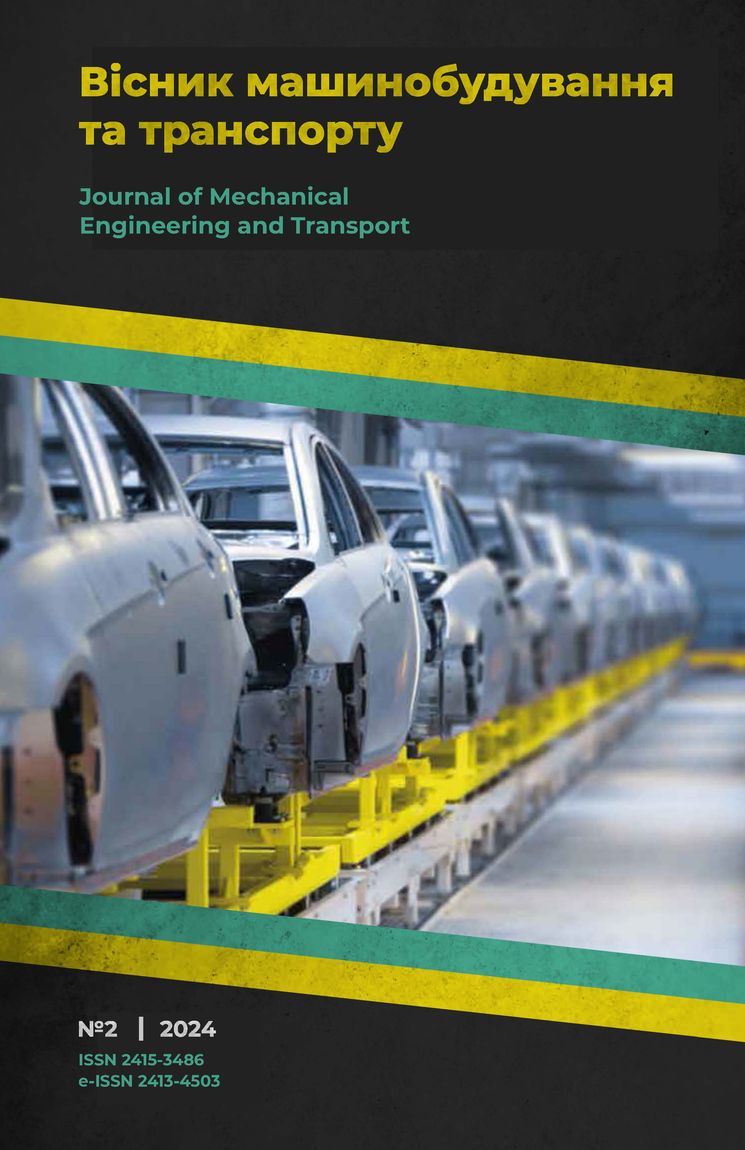Uncertainty and its impact on the formationof spare parts inventories to ensuring the efficiency of transport processes
DOI:
https://doi.org/10.63341/vjmet/2.2024.74Keywords:
vehicles; operational reliability; spare parts; uncertainty; efficiency; transport processAbstract
Improving the efficiency of transport processes is impossible without improving the logistics of managing spare parts inventories. The functioning of logistics processes in supply chains is accompanied by significant uncertainty and risks. The time that managers spend on eliminating disruptions in the supply chains of spare parts due to the impact of uncertainty on road transport is from 20% to 40% of the total time spent on ensuring logistics processes. This indicator can be reduced by implementing advanced supply chain management systems, using analytics to predict and prevent problems, as well as increasing the level of cooperation with suppliers. The article examines the main factors shaping the demand for spare parts. The causes of uncertainty and risks in supply chains are analysed. It is established that the uncertainty of demand factors for spare parts can be caused by a number of factors, such as fluctuations in economic conditions, seasonal changes, changes in technology, or even unforeseen situations, such as pandemics or natural disasters. These factors include human characteristics, technical means, operation and maintenance processes, and the external environment. For optimal resource allocation to ensure system reliability, it is necessary to prioritize influencing factors. Since many of these factors are qualitative and are assessed by experts, this complicates the application of traditional methods of experimental design and regression analysis, which are usually used in the statistical theory of reliability of “human-machine” systems. Analysis of sources of uncertainty in logistics processes of supply chains, methods for their reduction, as well as economic and mathematical methods for supporting decision-making regarding the structure and planning of work in supply chains allows us to identify a number of trends and promising areas of research in this area. These areas include: the need to form and develop a terminology base, improve methods for forecasting spare parts inventories, develop supply chain management strategies, minimize risks in supply chains, and find a balance between the efficiency and sustainability of inventory management systems
References
Snytiuk, V.E. (2008). Forecasting. Models. Methods. Algorithms. Kyiv: Maklaut.
Kashkanov, A.A., Buriak, V.V., & Moskaliuk, M.L. (2023). Aspects of logistic support of production processes of road transport enterprises of Ukraine. In Materials of the XVI international scientific and practical conference “Modern technologies and prospects for the development of road transport” (pp. 154-156). Vinnytsia: VNTU.
Kashkanov, V.A., Kashkanov, A.A., & Varchuk, V.V. (2017). Organization of road transport. Vinnytsia: VNTU.
Sharma R. (2023). Auto spare parts market research report 2032. Retrieved from https://dataintelo.com/report/global-auto-spare-parts-market?form=MG0AV3.
Industries & Markets. (n.d.). Retrieved from https://www.statista.com/studies-and-reports/industries-and-markets.
Kashkanov, A., & Moskaliuk, M. (2024). Methods of justification of spare parts stocks in the transport process management system. Journal of Mechanical Engineering and Transport, 10(1), 68-74. doi: 10.31649/2413-4503-2024-19-1-68-74.
Bondarenko, E., Dryuchin, D., Goncharov, A., Bulatov, S., & Feklin, E. (2023). Improving the efficiency of vehicle operation by defining the organizational and methodological parameters of the spare parts incoming inspection system. In A. Guda (Ed.) Networked control systems for connected and automated vehicles. NN 2022. Lecture notes in networks and systems (Vol. 509, pp. 1083-1089). Cham: Springer. doi: 10.1007/978-3-031-11058-0_110.
Kashkanov, A.A., & Bilichenko, V.V. (2004). Operation and maintenance of transport machines. Vinnytsia: VNTU.
Strelnikov, V.P., & Strelnikov, P.V. (2022). Defining the nomenclature of the spare parts sets and calculating the number of single sets of spare parts. Mathematical Machines and Systems, 2, 83-90. doi: 10.34121/1028-9763-2022-2- 83-90.
Subochev, O.I., Zavaliy, T.A., & Pogorelov, M.G. (2019). Improving the provision of spare parts for service enterprises. Central Ukrainian Scientific Bulletin. Technical Sciences, 1(32), 58-67. doi: 10.32515/2664-262X.2019.1(32).58-67.
Antoniuk, O.P. (2021). Improving the process of providing spare parts for rolling stock of a motor transport enterprise. (Doctoral dissertation, Zhytomyr Polytechnic State University, Zhytomyr, Ukraine).
Mika, S., & Pei, E. (2023). Additive manufacturing processes and materials for spare parts. Journal of Mechanical Science and Technology, 37, 5979-5990. doi: 10.1007/s12206-023-1034-0.
Kaya, B., Karabağ, O., & Fadıloğlu, M.M. (2024). Maintenance decision and spare part selection for multi-component system. In: N.M. Durakbasa & M.G. Gençyılmaz (Eds.) Industrial engineering in the Industry 4.0 era. (pp. 443-453). Cham: Springer. doi: 10.1007/978-3-031-53991-6_34.
Kashkanov, V.A., Kashkanov, A.A., & Kuzhel, V.P. (2020). Information systems and technologies in road transport. Vinnytsia: VNTU.
Burennikov, Yu.A., Kashkanov, A.A., & Rebedailo, V.M. (2009). Rolling stock of road transport: workflow processes and calculation elements. Vinnytsia: VNTU.
Wang, Q., Liu, C., Zheng, M., Wang, D., & Pan, E. (2024). Integrated planning of multiple spare parts inventory, warranty, and service engineers for a service-oriented manufacturer. In IEEE Transactions on Automation Science and Engineering, 22, 788-801. doi: 10.1109/TASE.2024.3354422.
Raaymann, S., & Spinler, S. (2024). Measuring supply chain resilience along the automotive value chain – a comparative research on literature and industry. Transportation Research Part E: Logistics and Transportation Review, 192, article number 103792. doi: 10.1016/j.tre.2024.103792.
Kashkanov, A.A. (2020). Methodology for assessing and reducing uncertainty in the tasks of automotive technical examination of road accidents. Journal of Mechanical Engineering and Transport,1(11), 71-78. doi: 10.31649/2413- 4503-2020-11-1-71-78.
Rotshtein, A., & Rakytianska, H. (2012). Fuzzy evidence in identification, forecasting and diagnosis. Berlin: Springer. doi: 10.1007/978-3-642-25786-5.
Boylan, J., & Syntetos, A. (2021). Intermittent demand forecasting: Context, methods and applications. Hoboken: John Wiley & Sons. doi: 10.1002/9781119135289.
Bacchetti, A., & Saccani, N. (2012). Spare parts classification and demand forecasting for stock control: Investigating the gap between research and practice. Omega, 40(6), 722-737. doi: 10.1016/j.omega.2011.06.008.
Woźniakowski, T, Jałowiecki, P, & Zmarzłowski, K. (2018). ERP systems and warehouse management by WMS. Information System in Management, 7(2), 141-151. doi: 10.22630/ISIM.2018.7.2.6.
Eaves, A.H.C., & Kingsman, B.G. (2004). Forecasting for the ordering and stock-holding of spare parts. The Journal of the Operational Research Society, 55(4), 431-437.
Rotshtein, A., Katielnikov, D., & Kashkanov, A. (2019). A fuzzy cognitive approach to ranking of factors affecting the reliability of man-machine systems. Cybernetics and Systems Analysis, 55, 958-966. doi: 10.1007/s10559-019-00206-8.
Downloads
-
PDF (Українська)
Downloads: 0



